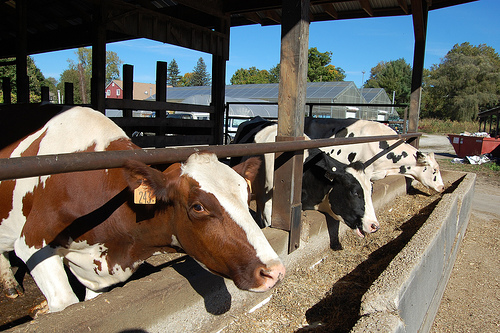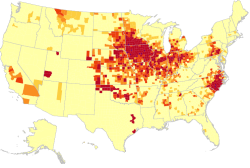
Photo courtesy of Save Family Farms.
When the Des Moines Register ran a front-page story last week calling into question the growth of concentrated animal feeding operations (CAFOs) in the state, it wasn’t environmentalists or animal rights activists who went on record against the facilities. No, the article featured ex-hog farmers who have been vocal in opposing new factory farms, as well as several Iowans who don’t want to see huge facilities — nor the “poo lagoons” that go along with them — take over the landscape.
Some 19.7 million pigs are raised in Iowa CAFOs every year, and that number is likely to keep climbing. A chart of livestock construction permits that ran with the Register story certainly projects growth. It reads:
2006……………310
2007………….. 252
2008………….. 218
2009……………. 60
2010…………….. 62
2011……………. 132
2012 (by 6/07).. 91
That’s right, after a “slump” in 2009 and 2010, the industry is back to its CAFO-building ways, with 91 permits issued so far this year. And remember, these are not small facilities; according to the Register, each facility contains around 4,400 hogs in two buildings.
Looking at these numbers, it’s easy to wonder: How much longer can the state (or the region for that matter) handle this kind of growth? When the nonprofit advocacy group Food and Water Watch created this Factory Farm Map back in 2007, Iowa was already one of the states most saturated with CAFOs (see image). According to the chart above, over 500 CAFOs may have been built since then. Of course not all that growth has to mean new operations — some permits may be for the expansion of preexisting buildings — but if even half that number resulted in new facilities, it’s a cause for concern.
Some of the manure created in these facilities gets spread on farm fields, which do absorb a portion of the nitrogen (while the rest erodes into waterways, leaches into the groundwater, and — ultimately — adds nitrous oxide (N2O), a dangerous greenhouse gas, to the atmosphere). I won’t even get into the number of antibiotics and other drugs each CAFO requires — both to boost the animals’ growth and to keep them from getting sick in crowded facilities. The bottom line is that the more CAFOs are built, the further out of balance the ratio of manure-to-farm-field becomes. In addition, the Register article points out that “such large-scale spreading of liquid manure is vulnerable to spills and tank ruptures.”
Eyes on the prize
Why exactly do we need so many new CAFOs if American meat consumption has gone down? The answer — as it is with so much economic growth these days — is China. Apparently, they’ve gone a little pork-crazy over there. And China just surpassed us as the nation with the biggest meat-tooth in the world (we’re still ahead of them on a per capita basis, but they have a lot more people than we do).
Another recent article in the Iowa Farm Journal reports on new free-trade agreements with South Korea, Colombia, and Panama, but zeroes in on China as the ultimate target of U.S. pork industry expansion. It quotes Laurie Hueneke, U.S. director of international trade policy, saying, “The biggest prize is China.”
Of course, there’s a catch-22 at work here. Along with antibiotics, the American pork industry relies heavily on ractopamine, or “paylean,” a controversial drug that promotes leanness in pigs. And, as Helena Bottemiller reported on MSNBC earlier this year, as part of an investigation for the Food and Environment Reporting Network, China wants nothing to do with ractopamine. The drug was shown to lead to an increase in the number of “downer pigs” — lame animals unable to walk in slaughter plants — and the company that makes the drug has apparently received hundreds of complaints from farmers about sick livestock. Chinese health officials, however, seem most worried about the traces of the ractopamine found in meat, which Bottemiller reported “can still be detected in animals more than a week after they’ve consumed the drug.”
Nonetheless, it’s hard to see how the pork industry isn’t expanding with China in mind. In fact, Hueneke told the Iowa Farm Journal the nation had “been encouraged to reassess the ractopamine issue.”
The sacrifice generation
The presence of more and more CAFOs isn’t the only way the highly consolidated meat industry has changed the Midwest in recent years. A Reuters article that ran on Friday told the story of a small Illinois town that’s home to a giant Cargill meatpacking plant. The (oddly upbeat) article details the way the town has been flooded with an influx of people from Africa and Latin America — some on a legal “diversity visa lottery.”
If you’ve read any of the recent coverage of the meatpacking industry’s treatment of its workers — such as last year’s groundbreaking coverage of a Minnesota-based Hormel factory, or my recent post about workers throughout the food chain — you know that it’s a brutal, often inhumane industry. But it does tend to pay better than much of the other work that new immigrants can find. For that reason, Cargill plants like the one in the article, which is described as “a 430,000-square-foot concrete slaughterhouse that turns almost 20,000 hogs a day into meat,” are more or less changing the face of immigration in this country. The plant and the surrounding community it employs are described as emblematic of the way job-seeking immigrants have begun moving to rural and suburban areas, rather than big cities like Chicago and New York.
And despite the Reuters article’s somewhat cheerful description of the new ethnic population of this Illinois town, it also admits to the grim reality:
Many immigrants at meatpacking plants are “the sacrifice generation” — people who know they’ll have to work at hard, menial jobs so their children can rise to something else.
And really, the scale of this shift probably shouldn’t surprise us. There’s been much coverage of the way rural America has essentially been emptying out in recent years. So, on the face of it, I can see why some residents may be encouraged to see some form — heck, any form — of industry return.
But taken alongside the expansion of CAFOs in states like Iowa, Missouri, Kansas, and Nebraska, the expansion of meatpacking plants in the same states suggests that companies like Cargill — “the biggest private company in the United States and the third-largest U.S. meatpacker” — might just be gearing up to rebuild vast swaths of the middle of the nation as the source of the world’s cheap meat. I can see the signs now: “You are now entering the Meatwest.”




